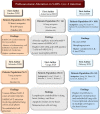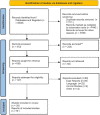Insights into the Role of Neutrophils and Neutrophil Extracellular Traps in Causing Cardiovascular Complications in Patients with COVID-19: A Systematic Review
- PMID: 35566589
- PMCID: PMC9104617
- DOI: 10.3390/jcm11092460
Insights into the Role of Neutrophils and Neutrophil Extracellular Traps in Causing Cardiovascular Complications in Patients with COVID-19: A Systematic Review
Abstract
Background: The coronavirus disease 2019 (COVID-19) pandemic caused by the SARS-CoV-2 virus has resulted in significant mortality and burdening of healthcare resources. While initially noted as a pulmonary pathology, subsequent studies later identified cardiovascular involvement with high mortalities reported in specific cohorts of patients. While cardiovascular comorbidities were identified early on, the exact manifestation and etiopathology of the infection remained elusive. This systematic review aims to investigate the role of inflammatory pathways, highlighting several culprits including neutrophil extracellular traps (NETs) which have since been extensively investigated.
Method: A search was conducted using three databases (MEDLINE; MEDLINE In-Process & Other Non-Indexed Citations and EMBASE). Data from randomized controlled trials (RCT), prospective series, meta-analyses, and unmatched observational studies were considered for the processing of the algorithm and treatment of inflammatory response during SARS-CoV-2 infection. Studies without the SARS-CoV-2 Infection period and case reports were excluded.
Results: A total of 47 studies were included in this study. The role of the acute inflammatory response in the propagation of the systemic inflammatory sequelae of the disease plays a major part in determining outcomes. Some of the mechanisms of activation of these pathways have been highlighted in previous studies and are highlighted.
Conclusion: NETs play a pivotal role in the pathogenesis of the inflammatory response. Despite moving into the endemic phase of the disease in most countries, COVID-19 remains an entity that has not been fully understood with long-term effects remaining uncertain and requiring ongoing monitoring and research.
Keywords: COVID-19; SARS-CoV-2 infection; coronary artery thrombosis; neutrophil extracellular traps (NETs).
Conflict of interest statement
The authors declare no conflict of interest.
Figures








Similar articles
-
Thromboembolic Disease and Cardiac Thrombotic Complication in COVID-19: A Systematic Review.Metabolites. 2022 Sep 22;12(10):889. doi: 10.3390/metabo12100889. Metabolites. 2022. PMID: 36295791 Free PMC article. Review.
-
Association between COVID-19 Diagnosis and Coronary Artery Thrombosis: A Narrative Review.Biomedicines. 2022 Mar 18;10(3):702. doi: 10.3390/biomedicines10030702. Biomedicines. 2022. PMID: 35327504 Free PMC article. Review.
-
SARS-CoV-2-triggered neutrophil extracellular traps mediate COVID-19 pathology.J Exp Med. 2020 Dec 7;217(12):e20201129. doi: 10.1084/jem.20201129. J Exp Med. 2020. PMID: 32926098 Free PMC article.
-
Vasculitis and Neutrophil Extracellular Traps in Lungs of Golden Syrian Hamsters With SARS-CoV-2.Front Immunol. 2021 Apr 12;12:640842. doi: 10.3389/fimmu.2021.640842. eCollection 2021. Front Immunol. 2021. PMID: 33912167 Free PMC article.
-
High Levels of Neutrophil Extracellular Traps Persist in the Lower Respiratory Tract of Critically Ill Patients With Coronavirus Disease 2019.J Infect Dis. 2021 May 20;223(9):1512-1521. doi: 10.1093/infdis/jiab050. J Infect Dis. 2021. PMID: 33507309 Free PMC article.
Cited by
-
Endothelial Damage, Neutrophil Extracellular Traps and Platelet Activation in COVID-19 vs. Community-Acquired Pneumonia: A Case-Control Study.Int J Mol Sci. 2023 Aug 25;24(17):13194. doi: 10.3390/ijms241713194. Int J Mol Sci. 2023. PMID: 37686001 Free PMC article.
-
SARS-CoV-2-Induced Myocarditis: A State-of-the-Art Review.Viruses. 2023 Apr 2;15(4):916. doi: 10.3390/v15040916. Viruses. 2023. PMID: 37112896 Free PMC article. Review.
-
Staphylococcus aureus Endocarditis Immunothrombosis.Metabolites. 2025 May 15;15(5):328. doi: 10.3390/metabo15050328. Metabolites. 2025. PMID: 40422904 Free PMC article. Review.
-
Current Knowledge of Enterococcal Endocarditis: A Disease Lurking in Plain Sight of Health Providers.Pathogens. 2024 Mar 7;13(3):235. doi: 10.3390/pathogens13030235. Pathogens. 2024. PMID: 38535578 Free PMC article. Review.
-
Myocarditis and Inflammatory Cardiomyopathy in Dilated Heart Failure.Viruses. 2025 Mar 27;17(4):484. doi: 10.3390/v17040484. Viruses. 2025. PMID: 40284927 Free PMC article. Review.
References
-
- Szekely Y., Lichter Y., Taieb P., Banai A., Hochstadt A., Merdler I., Oz A.G., Rothschild E., Baruch G., Peri Y., et al. The spectrum of cardiac manifestations in coronavirus disease 2019 (COVID-19): A systematic echocardiographic study. Circulation. 2020;142:342–353. doi: 10.1161/CIRCULATIONAHA.120.047971. - DOI - PMC - PubMed
-
- Lala A., Johnson K.W., Januzzi J.L., Russak A.J., Paranjpe I., Richter F., Zhao S., Somani S., Van Vleck T., Vaid A., et al. Mount Sinai Covid Informatics Center. Prevalence and impact of myocardial injury in patients hospitalized with COVID-19 infection. J. Am. Coll. Cardiol. 2020;76:533–546. doi: 10.1016/j.jacc.2020.06.007. - DOI - PMC - PubMed
Publication types
LinkOut - more resources
Full Text Sources
Miscellaneous

